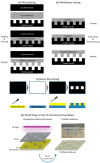Profiled Ion Exchange Membranes: A Comprehensible Review
- PMID: 30621185
- PMCID: PMC6337161
- DOI: 10.3390/ijms20010165
Profiled Ion Exchange Membranes: A Comprehensible Review
Abstract
Profiled membranes (also known as corrugated membranes, micro-structured membranes, patterned membranes, membranes with designed topography or notched membranes) are gaining increasing academic and industrial attention and recognition as a viable alternative to flat membranes. So far, profiled ion exchange membranes have shown to significantly improve the performance of reverse electrodialysis (RED), and particularly, electrodialysis (ED) by eliminating the spacer shadow effect and by inducing hydrodynamic changes, leading to ion transport rate enhancement. The beneficial effects of profiled ion exchange membranes are strongly dependent on the shape of their profiles (corrugations/patterns) as well as on the flow rate and salts' concentration in the feed streams. The enormous degree of freedom to create new profile geometries offers an exciting opportunity to improve even more their performance. Additionally, the advent of new manufacturing methods in the membrane field, such as 3D printing, is anticipated to allow a faster and an easier way to create profiled membranes with different and complex geometries.
Keywords: 3D printing; corrugated membranes; electrodialysis; hydrodynamic; ion exchange membranes; mass transfer; membrane capacitive deionization; profiled membranes; reverse electrodialysis; thermal pressing.
Conflict of interest statement
The authors declare no conflict of interest.
Figures








References
-
- Strathmann H. Electrodialysis, a mature technology with a multitude of new applications. Desalination. 2010;264:268–288. doi: 10.1016/j.desal.2010.04.069. - DOI
-
- Moon S.H., Yun S.H. Process integration of electrodialysis for a cleaner environment. Curr. Opin. Chem. Eng. 2014;4:25–31. doi: 10.1016/j.coche.2014.01.001. - DOI
-
- Paidar M., Fateev V., Bouzek K. Membrane electrolysis—History, current status and perspective. Electrochim. Acta. 2016;209:737–756. doi: 10.1016/j.electacta.2016.05.209. - DOI
-
- Pawlowski S., Crespo J.G., Velizarov V. Sustainable power generation from salinity gradient energy by reverse electrodialysis. In: Ribeiro A.B., et al., editors. Electrokinetics across Disciplines and Continents. Springer International Publishing AG; Basel, Switzerland: 2016. pp. 57–80. - DOI
-
- Tufa R.A., Pawlowski S., Veerman J., Bouzek K., Fontananova E., di Profio G., Velizarov S., Goulão Crespo J., Nijmeijer K., Curcio E. Progress and prospects in reverse electrodialysis for salinity gradient energy conversion and storage. Appl. Energy. 2018;225:290–331. doi: 10.1016/j.apenergy.2018.04.111. - DOI
Publication types
MeSH terms
Substances
Grants and funding
LinkOut - more resources
Full Text Sources

